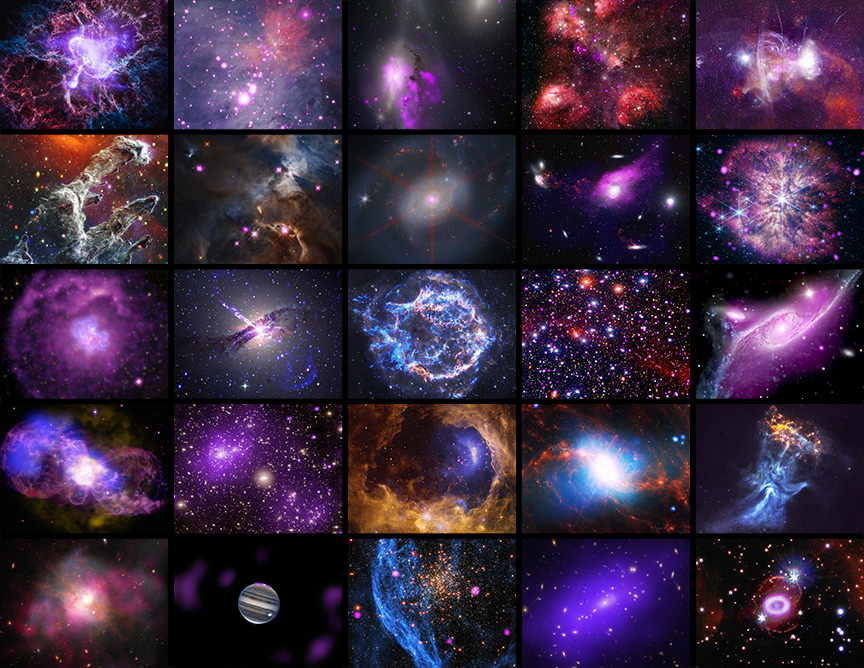Center for Astrophysics | Harvard and Smithsonian Celebrates 25 Years With the Chandra X-ray Observatory

This image shows a collection of 25 new space images celebrating the Chandra X-ray Observatory's 25th anniversary. Starting from the upper left, and going across each row, the objects imaged are: Crab Nebula, Orion Nebula, The Eyes Galaxies, Cat's Paw Nebula, Milky Way's Galactic Center, M16, Bat Shadow, NGC 7469, Virgo Cluster, WR 124, G21.5-0.9, Centaurus A, Cassiopeia A, NGC 3532, NGC 6872, Hb 5, Abell 2125, NGC 3324, NGC 1365, MSH 15-52, Arp 220, Jupiter, NGC 1850, MACS J0035, SN 1987A.
Credit: NASA/SAO/CXC.
To celebrate the 25th anniversary of its launch, the Chandra X-ray Observatory is releasing 25 never-before-seen views of a wide range of cosmic objects.
These images, composed of data from Chandra, demonstrate how X-ray astronomy explores all corners of the universe. By combining X-rays from Chandra with other space-based observatories and telescopes on the ground, astronomers can tackle the biggest questions and investigate longstanding mysteries across the cosmos.
“Chandra’s imagery and data have inspired people of all ages to think about what can be found when we look up into outer space,” said Ellen Stofan, Under Secretary for Science and Research at the Smithsonian. “Chandra continues to provide ‘X-ray eyes’ to allow us to better understand our place in the universe.”
On July 23, 1999, the space shuttle Columbia launched into orbit carrying Chandra, which was then the heaviest payload ever carried by the shuttle. With Commander Eileen Collins at the helm, the astronauts aboard Columbia successfully deployed Chandra into an elliptical orbit that takes it nearly one-third of the distance to the moon.
“We are proud of our history, excited about the present and looking forward to the future of X-ray astronomy,” said Lisa Kewley, director of the Center for Astrophysics | Harvard and Smithsonian, which includes the Smithsonian Astrophysical Observatory (SAO) in Cambridge, Massachusetts. “Chandra is a living legacy that we hope will continue to help us explore the universe for years to come.”
X-rays are an especially penetrating type of light that reveals extremely hot objects and very energetic physical processes. Many fascinating regions in space glow strongly in X-rays, such as the debris from exploded stars and material swirling around black holes. Stars, galaxies and planets also give off X-rays that can be studied with Chandra.
“For a quarter-century, Chandra has made discovery after amazing discovery,” said Pat Slane, director of the Chandra X-ray Center located at SAO. “Astronomers have used Chandra to investigate mysteries that we didn’t even know about when we were building the telescope—including exoplanets and dark energy.”
In 1976, SAO’s Riccardo Giacconi, who would go on to win the 2002 Nobel Prize in Physics for his work in X-ray astronomy, and Harvey Tananbaum, a senior astrophysicist at SAO and the former director of the Chandra X-ray Center, first proposed to NASA the mission that would one day become Chandra. Eventually, Chandra was selected to become one of NASA’s “Great Observatories,” along with the Hubble Space Telescope, Compton Gamma Ray Observatory and the Spitzer Space Telescope, each looking at different types of light.
Today, astronomers continue to use Chandra data in conjunction with other powerful telescopes, including the James Webb Space Telescope (JWST), Imaging X-ray Polarimetry Explorer (IXPE) and many more. For example, in the last year, Chandra’s collaboration with JWST has led to the discovery of evidence for two of the most distant black holes ever seen, and coordination with IXPE has revealed the “bones” of a ghostly cosmic hand, in studying an X-ray nebula created by a pulsar.
This new set of images is a sample of the almost 25,000 observations Chandra has taken during its quarter-century in space. Scientists have written over 10,000 peer-reviewed and accepted papers based on Chandra data, gathering almost a half-million citations. This makes it one of the most productive NASA missions in astrophysics, consistent with its excellent ranking in the most recent Senior Review (NASA’s “highest form of peer review”), conducted in 2022 by an independent panel of scientists.
NASA’s Marshall Space Flight Center manages the Chandra program. SAO’s Chandra X-ray Center controls the science from Cambridge, Massachusetts, and flight operations from Burlington, Massachusetts. Northrop Grumman Space Technologies in Redondo Beach, California, was the prime contractor for the spacecraft.
# # #
SI-248-2024
Megan Watzke
617-496-7998
mwatzke@cfa.harvard.edu
Benjamin Marcus
202-633-5194
marcusba@si.edu
Note: Individual images can be found on the Chandra webpage.
